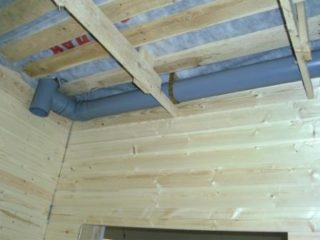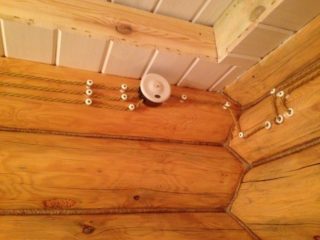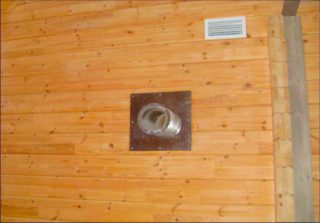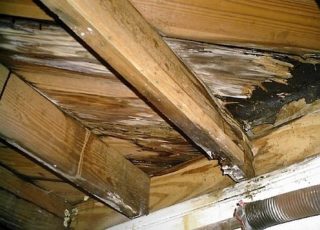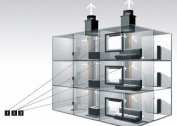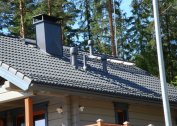A wooden house made of timber or logs has many advantages. It is environmentally friendly, safe for health, warm, wood is available in almost every region. But there are significant disadvantages associated with sensitivity to moisture and condensation. To reduce the detrimental effect of water on the house and the health of residents, you need to create a high-quality ventilation system.
Need for ventilation
In the construction of modern buildings made of concrete, brick and wood, technologies are used that reduce the amount of heat in the house. For heating, various devices are used that also burn oxygen from the air mass. This can be corrected by organizing a ventilation system.
Laying between the bars of various gaskets disrupts the natural circulation of air. It is influenced by plastic sealed windows and doors. As a result, fresh air does not enter the room, and stagnant air masses are not brought out, which leads to disruption of natural circulation.
Ventilation helps remove excess moisture. Vapors can cause fungal growth and the growth of harmful bacteria, as well as harm human health. Walls made of wood are not able to completely remove the resulting fumes, which is why ventilation systems are made.
Regulatory requirements
At the design stage of the building, ventilation in the log house should be provided. Norms are indicated in SNiP for the choice of air circulation speed, which are different for rooms for different purposes:
- 30 cubic meters per hour in living rooms;
- 50-70 cubic meters / hour for a kitchen with a gas and electric stove and a bathroom;
- 15 cubic meters / hour for utility rooms.
The main task of the designer is to ensure these standards. Appropriate materials and equipment are selected, as well as their location.
Types of ventilation systems for a wooden house
All ventilation systems are divided into two types according to the type of action: natural and forced. Natural ventilation in the log house involves the creation of vents and an exhaust duct. In this case, air exchange depends on weather factors. Mechanical circulation works regardless of weather and other factors. The movement of air is stimulated by fans, which are mounted in the supply and exhaust parts of the system. The optimal scheme for a wooden house is a combination of two methods. To do this, the fan mechanizes the exhaust or air flow.
Also, the system can be divided into supply, exhaust and supply and exhaust. The first work on the influx of fresh air, which will displace stagnant. The second remove the old air masses. The combined system includes both methods.
The installation may be equipped with a device that adjusts the air speed in the visit. Equipment is expensive; a special tool is required for its installation.
Many owners install recovery systems for heating air in the winter. They allow you to save on electricity, since it is possible to reduce the operating time of the heater. Also, such systems are used in the summer to cool air masses.
The ventilation system must necessarily go into the kitchen, toilet and bath. These rooms have the highest humidity in the house, as well as smells that must be removed from the house.
Creating ventilation in a wooden house
In order to choose the right ventilation system, it is necessary to make calculations according to the intensity of movement of air flows, take into account the number of people living in the house, the geometric dimensions and purpose of each room. Such calculations are best entrusted to specialists. After that, you can proceed to installation.
Step-by-step instructions for creating ventilation in the house consists of several stages. First of all, a system design is being done. It is necessary to take into account all the standards imposed by SNiP. Next, arrange the ventilation ducts and mount the air ducts.
At the end, the system is tested and checked for performance. If problems are found, they need to be fixed promptly. After correcting the defects, you can use the ventilation system.
Floor ventilation
Ventilation of the floor is an essential component in the air exchange at home. The presence of ventilation holes will allow to dry the base of the house and protect it from decay and microorganisms.
There are a number of rules for ventilation of the floor base:
- The vents are made with a diameter of about 10 cm from the windy and opposite sides of the cap. Between them a minimum distance of 33 cm must be observed.
- The gaps can be loosely covered with a plinth so that the incoming air can safely penetrate the house.
- Create holes that communicate with the underground. They can be covered with a grill.
- In the cold season, vents are closed with dampers. In the summer, grilles are put in their place.
- The distance between the vents should be two meters, if the house is located in a lowland. The distance is increased if the structure is high due to the strength and intensity of the wind.
If the floor is covered with dense material (linoleum), you need to make cuts for the ventilation.
Attic and attic ventilation
The durability of the roof and associated structures depends on proper air exchange in the attic. Air exchange is organized using the pediment ventilation windows. Their appearance is selected depending on the shape of the roof.
To exhaust the exhaust air masses, a ventilation shaft is created. In the summer, it can be equipped with a fan.
What to consider when ventilating the roof:
- If insulation is done, a small gap of 3-5 cm must be left between the insulation and the coating. Such a distance can be provided by the crate.
- A vapor barrier is mandatory so that moisture does not settle and condensation does not remain.
- Between waterproofing and insulation, a gap is also made.
Compliance with these requirements is necessary to ensure proper ventilation in a private house.
The use of air conditioners
The use of climate systems is not always justified. Ventilation of a room shows high efficiency in maintaining a good microclimate and the intake of fresh air. Air conditioning can be placed on the facade of a wooden house. Then the heating and cooling systems will save on heating.
All split systems are equipped with two units operating synchronously:
- The external unit condenses the refrigerant.
- The inner one is a radiator that heats the air around it.
There are models of air conditioners that take street air. But its share is less than 5%. It makes no sense to buy such products, since their price is too high, and they do not perform functions.
